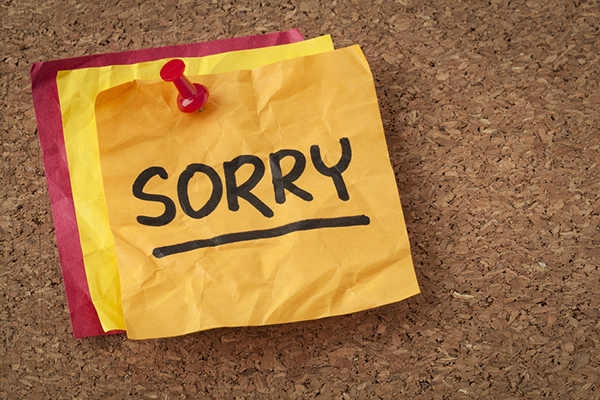
The art of an apology
When a crisis hits, immediate and blunt assessment is essential
“SORRY seems to be the hardest word.”
When it comes to apologies, Elton John’s lyric is all too true. Whether to say ‘sorry’ frequently divides the opinion of lawyers, insurers, clients and PR specialists. When a crisis hits, immediate and blunt assessment is essential: have we fouled up? If the answer is ‘yes’, then there is no getting away from the problem. Often, legal teams and insurers are understandably concerned about the extent of potential liability, but it is important to consider the longer-term issue of brand/individual reputation once the immediate heat of the crisis has cooled.
Why apologise?
Apologies are about accepting responsibility, and acting quickly to address those affected can work wonders. They are not about saving face. A timely apology, coupled with a pledge to fully investigate and put things right can make all the difference. It is what any reasonable person would expect in the circumstances, and shows a mature, responsible and professional approach is being taken. Failing to apologise, using weasel words in a ‘non-apology apology’, or simply leaving things too late, can all cause lethal and long-lasting reputational damage.
Make it timely
Earlier this month (March 2015) Mirror Group Newspapers paid the price for taking too long to apologise to actress Sadie Frost for hacking her phone.
She dismissed the gesture in a withering broadside against the company. “After over six months of litigation, MGN has finally sent me an apology and published an apology in the newspaper,” she said. “Whilst I wanted them to do this, the fact is that this is rather too little too late. I even said that I wanted an apology back in December, so it is quite telling that they waited this close to trial in order to do this.”
An apology has to be genuine, a public acknowledgement of culpability and regret – and it is quite unusual for this vulnerability to be exploited.
If carefully thought through, the apology locks the position, neutralising the immediate impact, and paving the way for the next stages – investigation, findings and positive change.
Make it real
US President Bill Clinton famously failed to strike the right note with his White House address of August 17, 1998, following his liaison with intern Monica Lewinsky:
“Indeed, I did have a relationship with Ms Lewinsky that was not appropriate. In fact, it was wrong. It constituted a critical lapse in judgement and a personal failure on my part for which I am solely and completely responsible.”
This was a statement, not an apology, and the American people didn’t buy it. Clinton was attacked for lacking any genuine regret, and later ruefully reflected: “I’m having to become quite an expert in this business of asking for forgiveness” – prompting yet more criticism.
Golfer Tiger Woods tried to apply sleight of hand following a bizarre domestic incident at his home in 2009.
His over-long statement mainly claimed he had been hounded by the media. “Personal sins should not require press releases, and problems within a family shouldn’t have to mean public confessions,” he said.
The nearest he got to apologising for anything was this paragraph: “I have let my family down, and I regret those transgressions with all of my heart. I have not been true to my values and the behaviour my family deserves. I am not without faults and I am far short of perfect.”
Make it sincere
The public has keen antennae for insincerity, and is invariably unforgiving when it is detected.
Phrases like: “We’re sorry if you were offended…” are, quite simply, toxic. Most people will understand that to mean: “We are responding to your public attack because we have to; you are clearly a precious idiot.”
An apology must be kept simple and straightforward. Including too much detail just gets in the way, and can even make things worse.
When drafting one, warning klaxons should sound whenever the words ‘if’ and ‘but’ crop up.
The presence of these words immediately poison your efforts because they indicate you are attempting to qualify the apology in some way, and cannot therefore mean what you say.
Conclusion
So, to recap:
- Unwelcome though it may be, early acknowledgement of a problem that is not going to go away is crucial.
- A short, genuine apology should be issued, together with a pledge to investigate and take any steps necessary to ensure the issue will not arise again. Mean what you say. If you find yourself working on a fourth paragraph, you’ve already gone too far.
- Avoid weasel words, ifs, and buts.
- Move swiftly into a new phase of communication that looks firmly forward.
Author: Anthony Longden, Consultant, Alder







